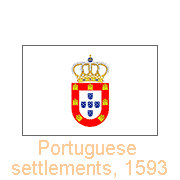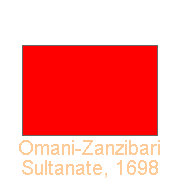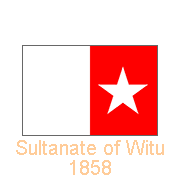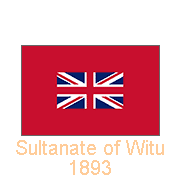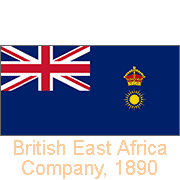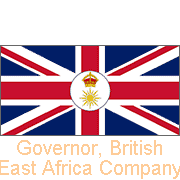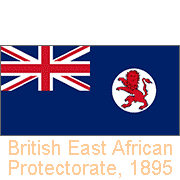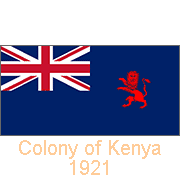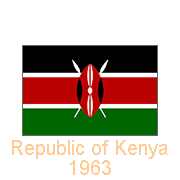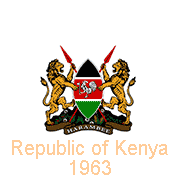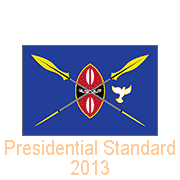Flags from Kenya
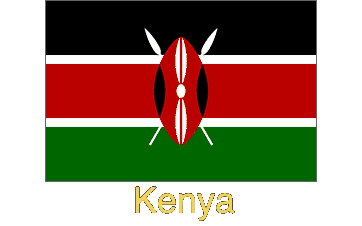
A Flag history of Kenya
The Portuguese explorer Vasco da Gama visited Mombasa in 1498, and two years later, the Portuguese sacked the city. During the 16th century, they had established themselves along the East African coast, captured Mombasa in 1593 and started building Fort Jesus the same year. The Portuguese flew a white flag charged with the arms: a white shield with five blue escutcheons, each charged with an undetermined number of bezants, surrounded by a red border with five yellow castles. A crown topped it; its design changed over the years.
you may then send it as a postcard if you wish.
In 1698, the Imam of Oman army captured Fort Jesus in Mombasa and defeated the Portuguese. It was briefly captured by the Portuguese in 1728, but a year later was back under Omani rule and declared itself independent in 1746, although Oman did not recognise this; it restored its control in 1837. The flag of all the Sultanates, from Arabia to the East Africa coast, was plain red.
The Sultanate of Witu, an approximately 3,000 km² area inland from the port of Lamu, north of Malindi, was founded in 1810 and became fully independent in 1858. It was a haven for slaves fleeing the Zanzibar slave trade. Its flag was vertically divided, white and red, with a large white 5-pointed star on the red stripe. Germany in 1885 signed treaties with chieftains in present-day Tanzania, causing protests by the Sultan of Zanzibar. Witu had suffered repeated raids by the Sultanate of Zanzibar to capture slaves, and the Sultan formally requested German protection, granted in the same year, 1885. As the result of a treaty between Britain and Germany, Witu was declared a British Protectorate on 18 June 1890, and the Germans renounced control on 1 July of that year. There were armed protests, and the British deposed Sultan Fumo Bakari ibn Ahmad. In 1893 the British hoisted a new flag: a plain red flag, like the flag of Zanzibar, of which Witu was made a vassal, but with a small Union Jack in the centre.
The Imperial British East Africa Company arrived in 1888 to develop trade in African areas controlled by the British Empire. In 1886 Germany and Britain had signed a treaty in which they agreed on spheres of influence on the East African coast that was part of the Sultanate of Zanzibar and the interior. Germany claimed the coast of present-day Tanzania, and Britain got access to present-day Kenya and Uganda. The company declared a protectorate and adopted as its flag the British Blue Ensign with the imperial crown and a yellow sun with 24 rays in the fly. On 1 July 1895, the British established the protectorate over their portion of East Africa, encompassing present-day Kenya and Uganda. Its flag was the British Blue Ensign with a red lion on a white disk in the fly. In 1920 the protectorate became the Colony of Kenya, and this flag remained unchanged. In 1920 the East Africa Protectorate became a colony and was renamed “Kenya”, after its highest mountain. Its flag was slightly changed the following year: it now featured the red lion directly on the British Blue Ensign.
On 12 December 1963, Kenya became independent: the Colony of Kenya and the Protectorate of Kenya (the area along the coast, leased from the Sultan of Zanzibar in the late 19th century) merged into one nation. Kenya adopted its new flag that same day. The colour black represents the people; red symbolises the bloodshed during the fight for independence, green stands the country’s landscape, and white fimbriation is added to indicate peace and honesty. Its coat of arms features two lions, symbols of protection, holding spears and a traditional East African shield in the national colours. The shield and spears symbolise unity and the defence of freedom. On the shield is a rooster holding an axe, the symbol of the Kenya African National Union (KANU) party that led the country to independence. The shield and lions stand on a silhouette of Mount Kenya with examples of Kenya agricultural produce. The scroll has Kenya’s motto, “Harambee”: Swahili for “pulling together” or “all for one”. Kenya formally became a republic on 12 December 1964. In 2013 the first general elections under the new constitution with limited presidential powers were held, and Uhuru Kenyatta, a son of Kenya’s first president Jomo Kenyatta, won the presidency. The Presidential Standard of Uhuru Kenyatta, who assumed office on 9 April 2013, features, on a blue background, a Maasai shield, two spears and a white dove.


